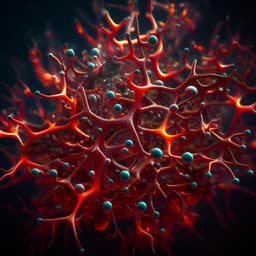Introduction
The demand for long-term monitoring of physiological signals and responsive therapeutics is increasing due to individual variability in clinical treatment responses. Implantable bioelectronic devices are crucial, but their widespread use is hindered by challenges such as incompatibility with biological media, tissue disruption, and difficulties in establishing interfaces for data and power exchange. Organic semiconductors offer biocompatibility and flexibility, but limitations in speed and integration have favored silicon-based technologies for advanced processing and data transmission. This research addresses these limitations by developing a fully organic, stand-alone bioelectronic device that integrates signal acquisition, processing, data transmission, and powering capabilities. Existing technologies like organic field-effect transistors (OFETs) and electrolyte-gated OFETs have limitations in transconductance and speed. Organic electrochemical transistors (OECTs) offer higher transconductance but suffer from slow response times and crosstalk issues. Internal ion-gated organic electrochemical transistors (IGTs) address some of these limitations, but further improvements in speed and integration density are needed for complex bioelectronic applications. This study aims to overcome these challenges and create a highly integrated and biocompatible device for advanced in vivo applications.
Literature Review
The paper reviews existing bioelectronic technologies, highlighting the advantages and limitations of organic and inorganic approaches. Organic field-effect transistors (OFETs) and their electrolyte-gated counterparts offer biocompatibility and flexibility, but their transconductance often limits their ability to resolve low-amplitude physiological signals. Organic electrochemical transistors (OECTs), while showing improved transconductance due to volumetric capacitance from redox reactions in the channel material, suffer from slower response times limited by ion mobility and the requirement for external electrolytes. Internal ion-gated organic electrochemical transistors (IGTs) previously developed by the authors improve upon OECTs by eliminating the need for external electrolytes and increasing bandwidth. However, the limitations of speed and integration density, especially when implanted in an ion-rich environment (such as physiological tissue), remain to be addressed. The authors also discuss the need for stand-alone devices incorporating power sources, data transmission methods, and signal processing capabilities, and the limitations of existing approaches in achieving conformability and biocompatibility.
Methodology
The researchers designed and fabricated vertical internal ion-gated organic electrochemical transistors (vIGTs) with a vertical channel arrangement and a micro-conduit (H-via) for hydration. The vIGT fabrication involved multiple steps including parylene deposition, metal lift-off processes, and spin coating of PEDOT:PSS-based channel material with D-sorbitol (for depletion mode) and PEI (for enhancement mode). Chitosan was used as the ion membrane. The H-via was created via photolithography and etching processes. The study characterized vIGT steady-state and temporal characteristics using techniques such as I-V measurements, electrochemical impedance spectroscopy, and time-of-flight measurements. The researchers investigated crosstalk using arrays of vIGTs and assessed long-term stability. The impact of contact area on temporal response was modeled and experimentally verified. The team then demonstrated large-scale vIGT array fabrication, creating conformable integrated circuits with high transistor densities. The functionality of these arrays was tested by developing various circuit components (inverters, oscillators, multiplexers, diodes), focusing on high-speed amplification and signal multiplexing capabilities. Finally, a stand-alone device was created that uses ionic communication (IC) for both wireless power transmission and data transmission to demonstrate in vivo application. This device was implanted in rats to record somatosensory evoked potentials (SSEPs) and spontaneous neural activity. The performance of the vIGT-based device was compared to a conventional neural interface device.
Key Findings
The vIGTs demonstrated high transconductance and sub-microsecond response times, surpassing existing organic and inorganic flexible transistors. The H-via effectively prevented crosstalk even in physiological media, enabling the creation of high-density (155,000 transistors cm⁻²) conformable arrays. The vIGTs exhibited long-term stability (over one year) in physiological conditions without encapsulation. The researchers successfully created and tested several circuit components using vIGTs, including high-gain amplifiers, oscillators, multiplexers, and diodes. A crucial finding was the ability to power vIGTs using high-frequency alternating current (AC) transmitted through the surrounding ionic media (ionic communication, IC). The AC powering approach provided sufficient power to operate the vIGTs while enabling wireless transmission of data encoded in the amplitude modulation of the carrier signal. In vivo experiments in rodents showed that the vIGT-based stand-alone device accurately acquired and wirelessly transmitted neurophysiological signals (SSEPs and spontaneous neural activity) with comparable signal-to-noise ratios to a conventional neural interface device. The generated power spectra and spectrograms were consistent with the known behavioral states of the animal, confirming the functionality and efficacy of the implanted device.
Discussion
The successful development and in vivo demonstration of the fully organic, conformable, stand-alone neural interface device based on vIGTs addresses a significant gap in the field of bioelectronics. The high performance, scalability, and biocompatibility of vIGTs offer advantages over existing technologies for applications requiring complex signal processing and high spatiotemporal resolution. The use of wireless power and data transmission eliminates the need for bulky batteries and cables, improving device implantability and long-term stability. The results highlight the potential of vIGTs for a range of clinical applications requiring minimally invasive and highly conformable implantable devices.
Conclusion
This work presents the first fully organic, conformable, stand-alone neural interface device enabled by the novel vIGT architecture. The vIGTs overcome limitations of previous organic transistors by achieving high speed, low voltage operation, and crosstalk-free integration in high-density arrays. The successful in vivo demonstration opens up new possibilities for advanced bioelectronic implants with improved biocompatibility, reduced invasiveness, and enhanced capabilities. Future research could focus on expanding the device's functionality, exploring different channel materials, and developing more sophisticated signal processing algorithms.
Limitations
While the study demonstrates significant advancements, some limitations exist. The in vivo experiments were conducted on a limited number of animals. Further studies with larger sample sizes are needed to validate the findings and assess long-term reliability. The current implementation of the wireless power and data transmission system is based on a specific frequency range. Investigating the optimal frequency range for different tissue types and application scenarios is crucial. The long-term biocompatibility and degradation characteristics of the device components should be further investigated. The research was conducted using a relatively simplified model of neural signaling. Future studies may focus on testing in more complex environments and exploring the implications of different signal processing methods for higher fidelity data acquisition.
Related Publications
Explore these studies to deepen your understanding of the subject.






